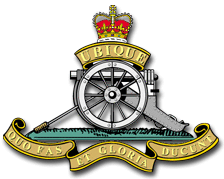86th Bty, Royal Field Artillery

Ashtead War
Memorials - WWI - Gnr Sidney Edwards
86th Bty, Royal Field Artillery

The marriage of John Edwards [born ca 1860, Rowhook/Rudgwick, Horsham, Sussex], a General Labourer, to Emily Ellen Longhurst [born Ashtead ca 1861], Housemaid, was registered at Epsom for the September Quarter 1884. By 1891, they had 5 children including a third son, Sidney, birth registered at Epsom 6/1888, and were living in Common Cottages [Job Curwood’s behind the pond on Barnett Wood Lane]. The 1901 Census has the family, grown to nine, in 5 The Flats, High Road, Ashtead but street directories for 1914-1918 mention John Edwards as the occupier of 2 Park Walk.
Sidney signed up for War Service before he was 18, initially being assigned to Royal Horse Artillery but, according to CWGC records, moving later to 86th Battery, Royal Field Artillery. In fact this reference seems to relate to 86th (Heavy) Battery, Royal Garrison Artillery that had come from India to be sent to Mesopotamia in March 1915. He entered '5(A) Asiatic' Theatre of War, MEF, on 25 August 1915 in time to join 6th (Poona) Indian Division, led by Sir Charles Townshend, for the Battle of Kut Al Amara.
“In the event the capture of Kut did not pose Townshend any great difficulty. Having successfully crossed the river his force attacked from the north on 28 September 1915. The Turks were thoroughly routed, losing approximately 5,300 men together with all their guns. A subsequent fall in the water level somewhat delayed Townshend's advance, enabling the bulk of the remaining Turkish force to escape and retire to prepared positions at Ctesiphon. Townshend, who was becoming ever more uncomfortable at the ongoing British advance in the face of increasing supply shortages, was nevertheless ordered by Nixon to advance towards Ctesiphon.”
http://www.firstworldwar.com/battles/kutalamara.htm
Eventually, Maj. Gen. Townshend fell back on Kut
where the forces under his command were besieged from 7 December
1915 until they surrendered on 29 April 1916.
http://en.wikipedia.org/wiki/Siege_of_Kut
Some 13,000 Allied soldiers were made prisoners of war.British accounts exist of captivity after Kut, but their authors are mostly officers who received far better treatment than the ranks of the Poona Division (the 6th Indian Division). About 70% of British soldiers who surrendered at Kut died in captivity afterwards, some in prisons in Baghdad, Mosul, and elsewhere, and others in the desert between those cities, casualties of gruelling marches. General Townshend, meanwhile, was sent to live in comfortable “captivity” near Constantinople. He was knighted by George V in 1917 while still a prisoner, for his service at Kut.
Sidney Edwards’ Medal Index Card suggests that he 'Died of Wounds, 29.4.1916' but that reflects a convention of using the date on which Kut fell for subsequent deaths in captivity up to 25 April 1917.
Major EWC Sandes in In Kut and Captivity with the Sixth Indian Division (London: 1919), pp. 269-270, says of after the surrender at Kut, in the first days as Turkish prisoners: -
“The great problem naturally was to feed the British and Indian troops rapidly assembling on this bare plain seven or eight miles from Kut. The Turkish camp, a mile farther up river, held all the available supplies, and the only food sent to us during the first day was some Turkish biscuits which were thrown on the ground and lay there in a dusty heap till distributed to us at 6 p.m. by our own Supply and Transport officers. The Turkish army biscuit is a curiosity in its way. Imagine an enormous slab of rock-like material, brown in colour, about 5 inches in diameter and 3/4 inch thick, made of the coarsest flour interspersed with bits of husk and a goodly proportion of earth, and you have a tolerable idea of the staple article of diet on which the Turkish soldier seems to thrive … There is no doubt that the Turkish biscuit, whatever its ingredients may be, is a nourishing form of food for a cast-iron interior, but does not agree with people weakened by a five-months siege.”
It would seem that Sidney survived until he succumbed to illness or starvation on 30 August 1916 and found a final resting place in Baghdad (North Gate) War Cemetery [recently restored by British troops on duty in Iraq.]
Further details of his incarceration might be found at The National Archives, Kew, in FO 383/334 Death and burial of British prisoners between 25.4.1916 & 17.2.1917 and FO 383/535 Turkey prisoners – British prisoners buried at Kut.
text by Brian Bouchard: if you can add to this page please contact the editor
page added 17 Mar 2009